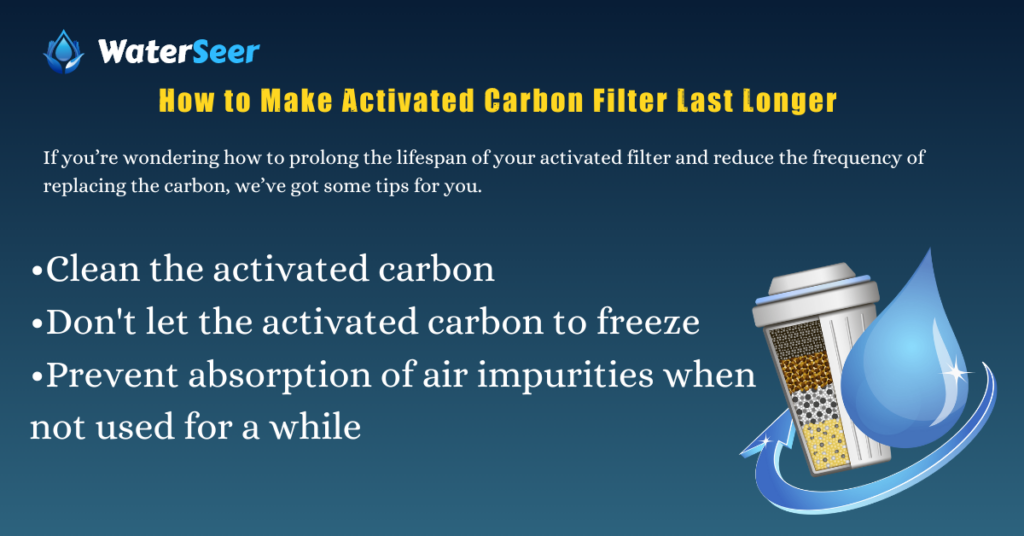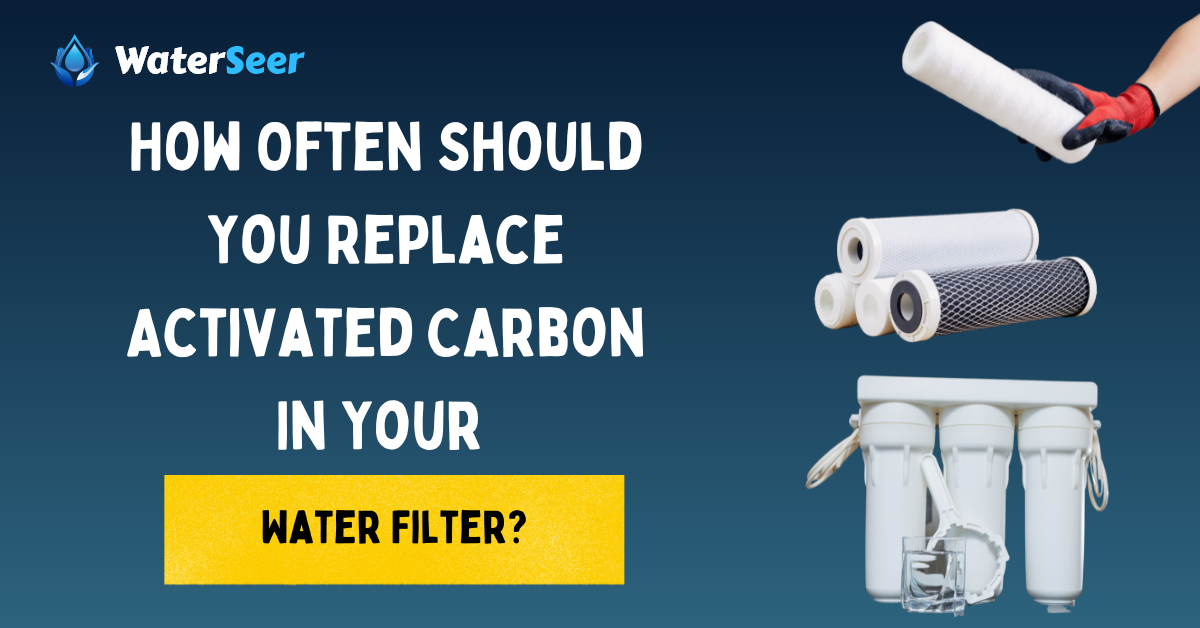Activated carbon filters (ACF) use heat or a booster to improve the time carbon comes in contact with the water, thereby improving its efficiency. The filter effectively blocks the water’s heavy metals, chlorine, and chloramine substances. This is why it is a popular water purification filter.
The activated carbon may be in powdered (PAC) or granules (GAC) to trap more dirt as the water passes through. In the process, activated carbon is clogged with impurities, reducing efficiency. In mild cases, you can clean the filter and get a decent usage period; however, replacing the filter is the right choice for more severe clogging.
Changing the activated carbon at the correct time is essential to ensure this filter continues to remove foul odor and taste, among other harmful metals. So how often should you change activated carbon in your filter? This is a question we’ll answer and more in this guide.
Why Should You Replace Activated Carbon?

Water filters are not built to last forever, and all have a life circle after which they must be replaced. For activated carbon, it is even more crucial to replace them after their lifespan has elapsed. Let’s see the reasons why you should replace activated carbon below:
1. Maintain Clean Water Efficiency
To continue getting purified water from the activated carbon filter, you must replace the carbon when it is past its lifespan. Since the activated carbon gets saturated with pollutants which can reduce efficiency, replacement at the correct time will ensure continued clean water delivery.
2. Minimal Cross-Contamination Risk
As the chemicals and heavy metals stockpile on the activated carbon, they can break loose and move back into the water, causing cross-contamination. Replacing the water before the activated carbon exceeds its limits will prevent cross-contamination.
3. Preventing The Growth of Micro-Organisms
Microorganisms grow and spread in the presence of organic matter. Without proper care, your filtration system may be breeding harmful micro-organisms that pollute the water. Replacing the activated carbon when due will prevent the growth or spread of these organisms.
4. Reducing Longterm Maintenance Costs
While regularly replacing your activated carbon may seem expensive, it can save you a lot of money in the long run. Simple maintenance practices like carbon replacement can prevent severe damages that significantly increase costs.
How Often Should You Replace Activated Carbon In Your Water Filter?
Depending on several factors, filters generally have varying lifespans, so it is vital to determine the frequency of changing your activated carbon for continued water purification. Knowing how often you need to change the activated carbon will help you continue to maintain purification levels, among other benefits.
Activated carbon brands usually add the ideal frequency to the carbon package so buyers get an idea. Depending on several factors, you should replace your activated carbon every 6 to 12 months. Remember that this figure is only to guide you and not serve as the rule.
While the lifespan based on the number of months is a popular metric, some brands give their figures based on the number of gallons the filter purifies. The number of gallon metric is closer to reality as facilities use varying amounts of water, which may be difficult to track in months.
Factors That Affect The Frequency of Changing Your Activated Carbon

Even manufacturers understand their figures are only guides, so they include clauses like “subject to physical conditions and usage” in their lifespan calculations. Here, we want to determine the factors that can affect the frequency of changing your activated carbon.
1. Quality of The Activated Carbon Filter
Particular brands have built reputations for making great quality products and have loyal customers. If you get a high-quality activated carbon, you should expect to change it less frequently than when buying an inferior product. Like most other devices, the better quality, the longer it’ll last.
2. The Volume of Filtered Water
As mentioned earlier, people have varying water needs, so the level of work the filter will do will vary. The more water the filter purifies, the more frequently you should expect to replace it. Filters will wear out quickly if they purify 400 grams of water every week against 100 grams.
3. Level of Impurity
The level of impurity in the water is similar to the abovementioned factor, making the filter work harder. If your water has more contaminants, the filter will get clogged faster and need cleaning and replacement than when purifying water with minimal chemicals. Run a water test to determine the amount of contaminants in the water, which may help you decide if you need to add other filtration systems like whole-house filters.
4. Type of Activated Carbon Filter
The type of activated carbon filter you buy will affect its lifespan and frequency of change as some are attached to separate faucets, while others are whole-house systems. Filters with different taps filter less water and will last longer. There’s also the case of capacity, as some types have the more expansive ability and will generally stay longer, not due to their quality but their capacity.
Signs You Need to Change Your Activated Carbon
Knowing the ideal lifespan of activated carbon and the factor affecting it, you may be wondering what to look out for before changing the carbon. Here are some signs that show you need to replace the activated carbon:
- Slower water flow: the working principle of activated carbon makes pollutants stick to the carbon and, over time, clog the pores, making it difficult for clean water to pass through. If you notice a slower water flow rate, it may be a sign the activated carbon is congested and needs replacing.
- Change in water taste and color: if you notice a difference in the shade or taste of your water, this is a massive indication that the filter is no longer effective and that you need to replace the activated carbon. When the activated carbon losses its effectiveness, it no longer blocks the contaminants causing an offensive odor and taste in the water.
How to Make Activated Carbon Filter Last Longer

If you’re wondering how to prolong the lifespan of your activated filter and reduce the frequency of replacing the carbon, we’ve got some tips for you.
- Clean the activated carbon: cleaning the activated carbon is a form of maintenance that prolongs the life of the carbon by some months. Thankfully, cleaning the activated carbon is easy but may take several days to complete the process, so that you may need an alternate clean water source within that period.
- Don’t let the activated carbon to freeze: freezing can cause tiny cracks in the carbon that creates room for impurities to pass through. Activated carbon filters installed in places like campers and vacation houses may be exposed to freezing in extreme temperatures. Winterize the carbon if you won’t be using them for a while.
- Prevent absorption of air impurities when not used for a while: activated carbon will absorb contaminants from water and air, so you should limit its contact with air when not used for some time. Drain the water and leave it in a zip lock to prevent it from absorbing air contaminants and reducing its lifespan.
FAQ’s
The exact frequency of replacing activated carbon may need to be clarified, raising several questions. Check out some common questions and their answers about the filter:
Is activated carbon hazardous?
Activated carbon is not hazardous before or during use but can be dangerous after removal as it contains harmful pollutants.
Is it possible to reactivate an already-used carbon filter?
Reactivating an already-used carbon filter is possible with the right supplies, as it requires excess steam or an inert gas chamber.
How long does activated carbon last in an aquarium?
It can last a few days to a few months, depending on the number of fish in the water, the bioload, and the amount of carbon activated.
Can you clean activated carbon?
You can clean activated carbon when mildly congested with pollutants; otherwise, you may be better off replacing the carbon instead of cleaning.
Conclusion
After understanding how often you should replace the activated carbon and the factors that affect it, maintaining the filter’s purification level should be seamless. Remember to take the manufacturers’ 6-12 months recommendation as a guide rather than the rule and instead use the factors affecting it to determine a more realistic timeframe for you.

